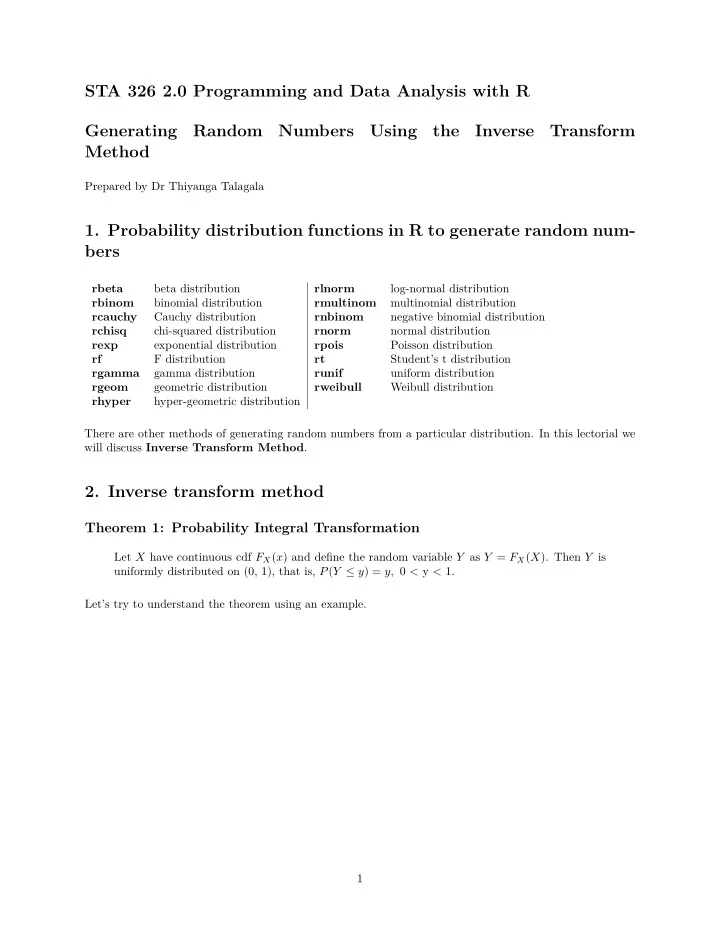

STA 326 2.0 Programming and Data Analysis with R Generating Random Numbers Using the Inverse Transform Method Prepared by Dr Thiyanga Talagala 1. Probability distribution functions in R to generate random num- bers rbeta beta distribution rlnorm log-normal distribution binomial distribution multinomial distribution rbinom rmultinom Cauchy distribution negative binomial distribution rcauchy rnbinom chi-squared distribution normal distribution rchisq rnorm exponential distribution Poisson distribution rexp rpois F distribution Student’s t distribution rf rt gamma distribution uniform distribution rgamma runif geometric distribution Weibull distribution rgeom rweibull hyper-geometric distribution rhyper There are other methods of generating random numbers from a particular distribution. In this lectorial we will discuss Inverse Transform Method . 2. Inverse transform method Theorem 1: Probability Integral Transformation Let X have continuous cdf F X ( x ) and define the random variable Y as Y = F X ( X ). Then Y is uniformly distributed on (0, 1), that is, P ( Y ≤ y ) = y, 0 < y < 1 . Let’s try to understand the theorem using an example. 1
2
Useful results to prove the theorem. Result 1: If F X is strictly increasing, then F − 1 is well defined by X F − 1 X ( y ) = x ⇔ F X ( x ) = y. If F X is constant on some interval, then F − 1 is not well defined by the above equation. To avoid this problem X we define F − 1 X ( y ) for 0 < y < 1 by F − 1 X ( y ) = inf { x : F X ( x ) ≥ y } . 3
Result 2: If F X is strictly increasing, then it is true that F − 1 X ( F X ( x )) = x. Proof of Theorem 1: For Y = F X ( X ) we have, for 0 < y < 1 , 4
We can use Theorem 1 to generate random numbers from a particular distribution. 5
3. Steps in deriving random numbers using integral transformation method 1. Derive the cumulative distribution function of f X ( x ) 2. Derive the inverse function F − 1 X ( u ). 3. Write a function to generate random numbers. • Generate u from Uniform (0 , 1). • compute x = F − 1 X ( u ). Example 1 Write a function to generate n random numbers from the distribution with density f X ( x ) = 3 x 2 , 0 < x < 1 . Step 1: Find the cumulative distribution function of f X ( x ), F X ( x ) = x 3 for 0 < x < 1 6
Step 2: Next we need to compute F − 1 X ( u ), 1 F − 1 3 . X ( u ) = u Step 3: R function generate_it <- function (n){ # Generate random numbers u <- runif (n) xgen <- u ^ (1 / 3) xgen } set.seed (2020) generate_it (10) 7
[1] 0.8648611 0.7332437 0.8520145 0.7812795 0.5143788 0.4069300 0.5054766 [8] 0.7325562 0.1372012 0.8527963 Visualisation of theoretical distribution library (tidyverse) # Theoretical distribution values theoretical.df <- tibble (x = seq (0, 1, 0.01), fx = 3 * x ^ 2) ggplot (theoretical.df, aes (x = x, y = fx)) + geom_line (col = "red") 3 2 fx 1 0 0.00 0.25 0.50 0.75 1.00 x Visualize empirical distribution - counts empirical.df <- data.frame (data.emp = generate_it (1000)) # Plot empirical distribution - counts ggplot (empirical.df, aes (x = data.emp)) + geom_histogram (col = "white", binwidth = 0.05) 100 count 50 0 0.25 0.50 0.75 1.00 data.emp 8
Visualize empirical distribution - density ggplot (empirical.df, aes (x = data.emp, y=..density..)) + geom_histogram (col = "white", binwidth = 0.05) 2 density 1 0 0.25 0.50 0.75 1.00 data.emp Visualize theoretical distribution and empirical distribution together ggplot (empirical.df, aes (x = data.emp, y=..density..)) + geom_histogram (col = "white", binwidth = 0.05) + geom_line (data = theoretical.df, aes (x = x, y = fx), color = 'red') 3 2 density 1 0 0.00 0.25 0.50 0.75 1.00 data.emp 9
Function to generate random numbers and visualize theoretical and empirical distributions generate_it_dist <- function (n){ # Generate random numbers u <- runif (n) xgen <- u ^ (1 / 3) xgen # values for empirical distribution empirical.df <- data.frame (xgen=xgen) # values for the theoretical distribution theoretical.df <- tibble (x = seq (0, 1, 0.01), fx = 3 * x ^ 2) # arrange values and plot into a list list ( xgen, ggplot2 ::ggplot (empirical.df, aes (x=xgen, y=..density..)) + geom_histogram (col="white", binwidth = 0.01) + geom_line (data = theoretical.df, aes (x = x, y = fx), color = 'red') ) } Run the following codes and check the outputs. # Sample size 10 generate_it_dist (10) # Sample size 100 n100 <- generate_it_dist (100) n100 n100[[1]] n100[[2]] # Sample size 10000 n10000 <- generate_it_dist (10000) n10000[[2]] 10
Example 2 i) Write a function to generate random numbers from the Exponential ( λ ) distribution using the inverse transformation method. ii) Generate 1000 random numbers from the Exponential (2) distribution. 11
iii) Graph the density histogram of the sample with the Exponential (2) density superimposed for compari- son. 12
Recommend
More recommend